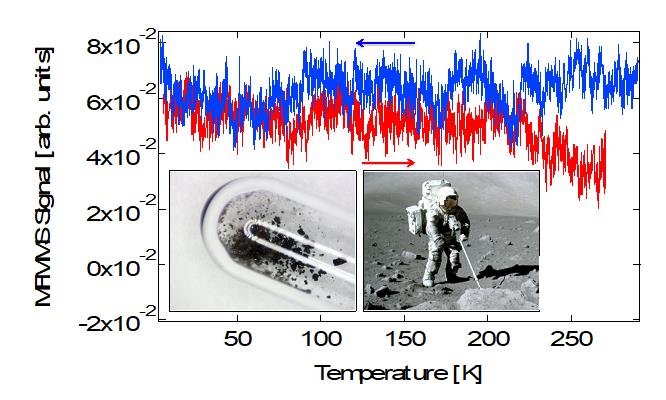The Search for New Superconductors in Extraterrestrial Materials
Previous studies have shown that Meteorites can contain unusual natural phases, such as quasicrystals, that have otherwise been found only in synthetic samples [1]. Because of this, meteorites are good candidates to search for natural superconductivity, which has only been found in Covellite [2].
 Figure 1.
Figure 1.
Nature article featuring micrometeorite samples we later measured.
Because natural samples are inhomogeneous and superconducting phases can be very small, we used Magnetic Field Modulated Microwave Spectroscopy (MFMMS) [3], which can detect 10-12 cc of superconducting material, three orders of magnitude better than Vibrating Sample Magnetometry (VSM).
 Figure 2.
Figure 2.
Samples from the Mundrabilla Iron Meteorite were measured in the MFMMS.
We have measured micrometeorites [4], meteorites [5] (see figures 1 and 2) as well as samples returned to the Earth by the Apollo 17 mission (see figure 3). We have characterized the phases within those samples using MFMMS, VSM, Energy-dispersive X-ray spectroscopy (EDX) and Inductively Coupled Plasma Mass Spectroscopy (ICPMS).
 Figure 3.
Figure 3.
MFMMS measurement and photo of sample taken from the Moon and returned to Earth by the Apollo 17 mission. Photo (right inset) of Harrison Schmidt collecting samples during the Apollo 17 mission. [6]
[2] F. Di Benedetto, et al., Eur J Mineral, 18 283 (2006)
[3] J. de la Venta et al. Supercond. Sci. Technol., 24 075017 (2011)
[4] S. Guenon et al., Scientific Reports, 4 7333 (2014)
[5] S. Guenon et al., J Supercond Nov Magn, 30 297 (2017)
[6] NASA/Eugene Cernan, https://www.nasa.gov/sites/default/files/styles/side_image/public/apollo_17-full.jpg
